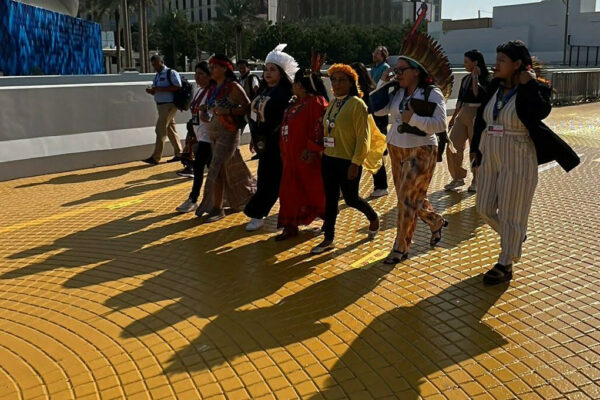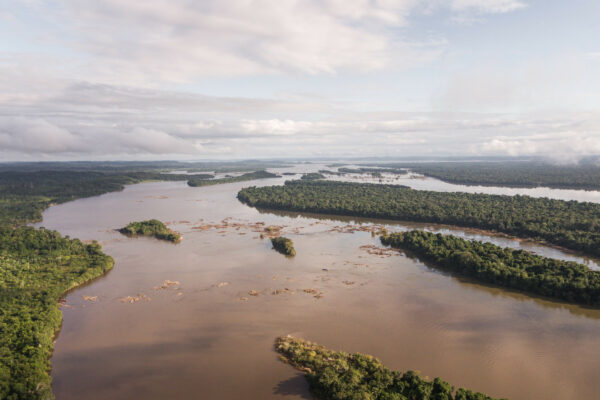Santarém, Para, Brazil – For the people of the Amazon, the forests and the rivers are life. That is why they mobilized at the V Pan Amazon Forum (November 25-29, 2010) in Santarem, Para – a site of a proposed mega-dam – in a global call to protect the rivers of the Amazon. Over 700 participants of the Forum, including students and local community members many of whom are threatened by dams and deforestation, joined Amazon Watch and John Quigley/Spectral Q in creating a massive human banner on the San Sebastian Plaza, a beach on the Tapajós River -a major tributary of the Amazon River. This action was organized in coordination with the EARTH 350 Art Exhibit taking place in 188 countries to bring awareness to the global climate crisis as global decision-makers resume climate talks at the UNFCC COP 16 in Cancun, México next week.
The human banner image is of Yara, the mythical mermaid who is the protector of the Amazon, and the message is “Rios Vivos” or “The Rivers Are Alive“. This action was organized in opposition to the Brazilian Government’s plans to construct more than 60 hydroelectric dams on important tributaries including the Tapajos and the Xingu, a plan which would be disastrous for forests, communities and the global climate.
Prior to forming the human banner, students gathered petition signatures against the proposed construction of the Belo Monte Dam on the Xingu River to support the Xingu Forever Alive Movement. Then, they marched through the streets of Santarém in peaceful protest against the proposed construction of dams throughout the Amazon. They held signs that read, “Rivers for Life for the People of the Amazon”, “The Youth Do Not support Dams in the Amazon”, “No to Large-Dams! Yes to Alternative Energy!”, “We want development, but not any kind of development”.
“Economic development needs to be sustainable. Are so many dams actually neccessary? Why doesn’t the government invest all the billions dedicated to dams into education instead? If Brazil wants to grow, it’s neccessary that we remember that developed countries got to where they are at because they invested in education,” said Tiago dos Anjos, a 20 year-old student and founder of the Student Union called UGEL.
“The Rivers are Alive is a global message brought by the youth of Santarém that understand the need to protect the rivers of the Amazon and support cleaner forms of energy production that are much less destructive than large-dams,” said Christian Poirier, Amazon Watch’s Brazil Campaigner from Santarém.
If built, the Belo Monte Dam will be the third largest in the world, after the Three Gorges dam in China and the Itaipu dam on the Brazil/Paraguay border. The $17 billion project would divert nearly the entire flow of the Xingu River along a 62-mile (100km) stretch; its reservoirs would flood more than 100,000 acres of rainforest and local settlements, displace more than 40,000 Indigenous and local people, thousands from the city of Altamira where up to a third will be flooded. Its reservoirs will also generate high amounts of methane – a greenhouse gas 25-40 times more potent than carbon dioxide. According to Dr. Philip Fearnside, a research professor at the Department of Ecology at the National Institute for Research in the Amazon (INPA), in Manaus, Brazil, huge areas of forest are flooded when reservoirs are built. The trees and other plant material decay at the bottom of the reservoir trapping methane until it is released by turbines.
Large dams, such as the Belo Monte or the Tapajós, can create as much greenhouse gas emissions as a coal-fired power plant of the same generating capacity. Large dams pose a major threat to the integrity of the Amazon’s forests, driving the expansion of massive mining operations and spurring waves of new settlers into protected areas and Indigenous territories.
For more information on the Belo Monte Dam visit:

Photo Credit: Atossa Soltani, Amazon Watch / Spectral Q
Caminhada e faixa humana marcam segundo dia do Fórum Social Panamazônico
700 pessoas formaram uma faixa humana em praia de Santarém. Ação ocorreu com participantes de caminhada contra a construção de grandes usinas hidrelétricas na Amazônia
O segundo dia do Fórum Social Panamazônico foi marcado pela realização de uma faixa humana na praia em frente à Praça São Sebastião, formada por 700 jovens de diversas escolas estaduais de Santarém. Juntos, eles formaram a imagem da indígena Yara segurando uma cuia com o corpo em frente ao rio Tapajós. Tecidos na cor verde exibiam a mensagem “Rios Vivos”.
Esta ação foi idealizada pela ONG Amazon Watch e contou com o trabalho de John Quigley, do projeto Spectral Q – ele tem mais de 20 anos de experiência na montagem de faixas humanas ao redor do mundo. Esta parceria também rendeu uma faixa humana na abertura do Fórum Social Mundial de 2009, em Belém.
Por volta de 11h20, um satélite sobrevoou o local e fotografou o desenho do espaço. Ao mesmo tempo, outras ações como essa ocorreram em mais de 188 países, em uma manifestação pública global contra a crise climática organizada pela 350.org.
Antes de formarem a imagem no chão os jovens, mobilizados pela União de Grêmios Estudantes Livres (UGEL), realizaram uma caminhada pacífica contra a construção de usinas hidrelétricas na Amazônia. “A mensagem ‘rios vivos’ é global e veio totalmente de encontro com o apoio da juventude de Santarém, que compreende esta mensagem e se posiciona a favor de formas bem menos destrutivas para geração de energia”, afirma Christian Poirier, da campanha Brasil da Amazon Watch.
Caminhada contra hidrelétricas
Durante a caminhada, que começou às 10h30, estudantes levantaram faixas com diferentes frases, como “desenvolvimento sim, de qualquer jeito não”, “rios vivos pela vida dos povos da floresta”, “nossa juventude não apoia hidrelétricas na Amazônia” e “não a grandes hidrelétricas, sim a energias alternativas”.
“O desenvolvimento econômico precisa ser sustentável. Será que tantas barragens são mesmo necessárias? Que tal se, no lugar de investimentos bilionários em hidrelétricas o governo fizesse investimentos bilionários em educação? Afinal, se o Brasil deve crescer, precisamos nos lembrar que países desenvolvidos chegaram a este ponto porque investiram em educação”, afirma Tiago dos Anjos, de 20 anos, fundador da UGEL.
Petição
Antes da caminhada, estudantes de Santarém se mobilizaram para recolher assinaturas para uma petição encabeçada pelo Movimento Xingu Vivo para Sempre (MXVPS) contra a construção da hidrelétrica de Belo Monte. Se construída, a usina vai desviar e secar o Rio Xingu em um trecho de 100 quilômetros em uma região conhecida como Volta Grande, o que deixará povos indígenas, ribeirinhos, populações extrativistas e agricultores familiares sem água, peixe e meios de transporte. Além disso, vai inundar uma área de 668 quilômetros quadrados, inclusive parte da cidade de Altamira, o que inevitavelmente acarretará em perda da biodiversidade, aumento de doenças como a malária, emissões de gases de efeito estufa e outros graves problemas socioambientais.
A petição também é online, pode ser assinada via site do MXVPS e será formalmente entregue ao presidente Lula, além dos presidentes do IBAMA, da FUNAI, do BNDES e do Tribunal Regional Federal da 1a Região.
Informações para a imprensa:
Christian Poirier, 93 8112 9396, christian@amazonwatch.org
Karina Luna, 93 8112 9344, comunicacaoamazonwatch@gmail.com













